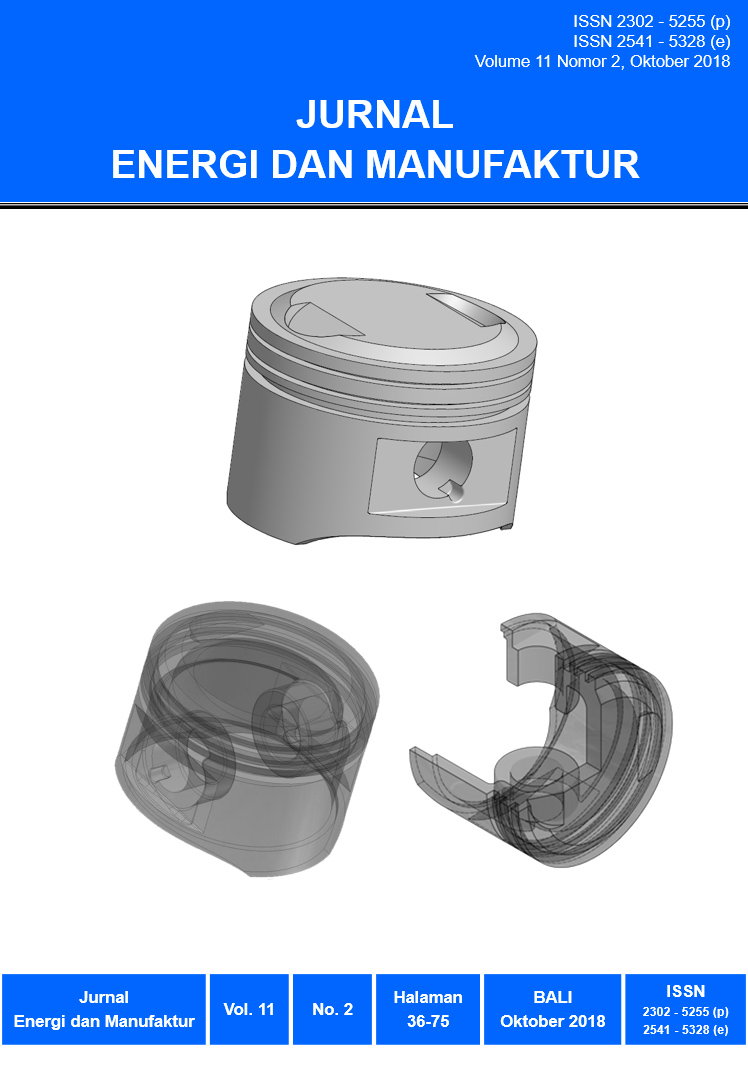Pengaruh Temperatur Sinter Terhadap Kekerasan dan Keausan Kampas Rem Berbasis Komposit Hibrida Serbuk Tempurung Kelapa/Alumina/Phenolic Resin
Abstract
Penelitian ini menginvestigasi sifat kekerasan dan keausan kampas rem komposit hibrida. Komposit hibrida berbasis penguat adalah serbuk tempurung Kelapa dan alumina dengan matriks phenolic resin. Benda uji diproduksi menggunakan hot press pada temperatur sinter bervariasi dari 200oC, 250oC dan 300oC. Tujuan penelitian adalah menentukan tingkat kekerasan, laju keausan dan koefisien gesek dari komposit hibrida. Pengujian dilakukan dengan menggunakan pin-on-disk dan Vikers berdasarkan standar masing-masing ASTM E-92 dan ASTMG99-95a. Hasil pengujian ditunjukkan temperatur sinter telah signifikan menurunkan koefisien gesekan, walaupun pada benda uji A dengan temperatur sinter 200oC masih lebih tinggi dari benda uji control sebesar 3.54%. Kemudian, nilai kekerasan HV untuk komposit hibrida pada temperatur sinter 300oC adalah 9.3% lebih tinggi dari pada kontrol. Kesimpulan adalah komposit hibrida dengan komposisi 40% serbuk tempurung kelapa dan 20% alumina potensial diaplikasikan untuk bahan alternatif kampas rem kendaraan bermotor.
This research investigates the hardness and wear behavior of hybrid composite brake pad. Hybrid composite was manufactured base on particles coconut cell and alumina reinforced and phenolic resin matrix. The specimens were produced by using the hot press according to temperatures variation of 200oC, 250oC and 300oC. The research purpose to determine hardness ability, wear rate, and friction coefficient of hybrid composites. Pin-on-disk and Vickers test have been employed according to the ASTM E-92 dan ASTMG99-95a, respectively. The result shows that sintering temperature have been significant decreased friction coefficient, while on specimen A with 200oC sinter temperature has 3.54% higher than control specimen. In addition, the hardness (HV) number of hybrid composite on 300oC sinter temperatures has 9.3% higher than control. Conclusion, hybrid composite with composition 40% coconut cell particles and 20% alumina has potential as alternative material of the vehicle brake pad application.
Downloads
References
[2] R.U. Rao, G. Babji, A Review paper on alternate materials for Asbestos brake pads and its characterization, (2015).
[3] U.D. Idris, V.S. Aigbodion, I.J. Abubakar, C.I. Nwoye, Eco-friendly asbestos free brake-pad: Using banana peels, Journal of King Saud University - Engineering Sciences 27 (2015) 185-192.
[4] R. Yun, P. Filip, Y. Lu, Performance and evaluation of eco-friendly brake friction materials, Tribology International 43 (2010) 2010-2019.
[5] M. Kumar, B.K. Satapathy, A. Patnaik, D.K. Kolluri, B.S. Tomar, Hybrid composite friction materials reinforced with combination of potassium titanate whiskers and aramid fibre: Assessment of fade and recovery performance, Tribology International 44 (2011) 359-367.
[6] P.I. Purboputro, Pengembangan Kampas Rem Sepeda Motor Dari Komposit Serat Bambu, Fiber Glass, Serbuk Aluminium Dengan Pengikat Resin Polyester Terhadap Ketahanan Aus Dan Karakteristik Pengeremannya Seminar Nasional Aplikasi Sains & Teknologi (SNAST) Periode III Yogyakarta, 2012 pp. 367-373.
[7] J. Olumuyiwa Agunsoye, Talabi S. Isaac, S.O. Samuel, Study of Mechanical Behaviour of Coconut Shell Reinforced Polymer Matrix Composite, Journal of Minerals and Materials Characterization and Engineering 11 (2012) 774-779.
[8] S. Balaji, K. Kalaichelvan, Optimization of a Non Asbestos Semi Metallic Disc Brake Pad Formulation with Respect to Friction and Wear, Procedia Engineering 38 (2012) 1650-1657.
[9] S.W. Yoon, M.W. Shin, W.G. Lee, H. Jang, Effect of surface contact conditions on the stick–slip behavior of brake friction material, Wear 294-295 (2012) 305-312.
[10] K. W. Liew, Umar Nirmal, Frictional performance evaluation of newly designed brake pad materials, Materials & Design 48 (2013) 25-33.
[11] Poh Wah Lee, P. Filip., Friction and wear of Cu-free and Sb-free environmental friendly automotive brake materials, Wear 302 (2013) 1404-1413.
[12] Faris M. AL-Oqla, S.M. Sapuan., Natural fiber reinforced polymer composites in industrial applications: feasibility of date palm fibers for sustainable automotive industry, Journal of Cleaner Production 66 (2014) 347-354.
[13] J.R. Laguna-Camacho, G. Juárez-Morales, C. Calderón-Ramón, V. Velázquez-Martínez, I. Hernández-Romero, J.V. Méndez-Méndez, M. Vite-Torres, A study of the wear mechanisms of disk and shoe brake pads, Engineering Failure Analysis 56 (2015) 348-359.
[14] F. Ahmad, S.H.J. Lo, M. Aslam, A. Haziq, Tribology Behaviour of Alumina Particles Reinforced Aluminium Matrix Composites and Brake Disc Materials, Procedia Engineering 68 (2013) 674-680.
[15] W. Österle, C. Deutsch, T. Gradt, G. Orts-Gil, T. Schneider, A.I. Dmitriev, Tribological screening tests for the selection of raw materials for automotive brake pad formulations, Tribology International 73 (2014) 148-155.
[16] M.R. Mansor, S.M. Sapuan, E.S. Zainudin, A.A. Nuraini, A. Hambali., Hybrid natural and glass fibers reinforced polymer composites material selection using Analytical Hierarchy Process for automotive brake lever design, Materials and Design 51 (2013) 484-492.
[17] G.-P. Ostermeyer, M. Graf, Influence of wear on thermoelastic instabilities in automotive brakes, Wear 308(1-2) (2013) 113-120.
[18] M. Kchaou, A. Sellami, R. Elleuch, H. Singh, Friction characteristics of a brake friction material under different braking conditions, Materials & Design 52 (2013) 533-540.
[19] D. Gultekin, M. Uysal, S. Aslan, M. Alaf, M.O. Guler, H. Akbulut, The effects of applied load on the coefficient of friction in Cu-MMC brake pad/Al-SiCp MMC brake disc system, Wear 270 (2010) 73-82.

This work is licensed under a Creative Commons Attribution-NonCommercial-ShareAlike 4.0 International License.









